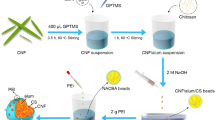Abstract
A linear bacterial β-1,3-glucan, curdlan, was functionalized by ethylenediamine tetraacetic dianhydride (EDTAD) to form a porous insoluble material (Curd-E) in this study. Various technics, including FTIR, solid state 13C NMR, XRD, TGA, and SEM, were combined to determine the chemical and microscopic structure of the resultant. It's suggested that EDTAD esterified and cross-linked C6-hydroxyl groups of curdlan molecules to form the porous Curd-E. Moreover, Curd-E showed high adsorption capacity on Cu2+ (224.97 mg/g, pH 6.0) and Zn2+ (255.64 mg/g, pH 4.5) in comparison with the biomaterial and mineral based adsorbents. Data also indicated that the site affinity of Curd-E for cations was in the order of chelation > coordination/complexation > ion exchange. Besides, 2-site Langmuir and 2-step Freundlich isotherms gave the best interpretation for Cu2+ adsorption and Zn2+ adsorption, respectively. Since the adsorption capacity maintained 91.8% ± 0.8% after five cycles of adsorption/desorption, it is believed that Curd-E is suitable for removal of divalent cations in wastewater as a novel candidate.





Similar content being viewed by others
References
Pacyna JM, Pacyna EG (2001) Environ Rev 9:269
Lei K, Giubilato E, Critto A, Pan H, Lin C (2016) Environ Sci Pollut Res 23:13128
Shi GL, Lou LQ, Zhang S, Xia XW, Cai QS (2013) Environ Sci Pollut Res 20:8435
Yagub MT, Sen TK, Afroze S, Ang HM (2014) Adv Colloid Interfac 209:172
Wan Ngah WS, Teong LC, Hanafiah MAKM (2011) Carbohydr Polym 83:1446
Mohan D, Pittman CU (2006) J Hazard Mater 137:762
Cui L, Wang Y, Gao L, Hu L, Yan L, Wei Q, Du B (2015) Chem Eng J 281:1
Sitko R, Musielak M, Zawisza B, Talik E, Gagor A (2016) RSC Adv 6:96595
Ahmad M, Manzoor K, Chaudhuri RR, Ikram S (2017) J Chem Eng Data 62:2044
Kara İ, Yilmazer D, Akar ST (2017) Appl Clay Sci 139:54
Fideles RA, Ferreira GMD, Teodoro FS, Adarme OFH, da Silva LHM, Gil LF, Gurgel LVA (2018) J Colloid Interface Sci 515:172
Li M, Messele SA, Boluk Y, Gamal El-Din M (2019) Carbohydr Polym 221:231
Qin L, Feng L, Li C, Fan Z, Zhang G, Shen C, Meng Q (2019) J Clean Prod 228:112
Noradoun CE, Cheng IF (2005) Environ Sci Technol 39:7158
Almeida FTR, Ferreira BCS, Moreira ALDSL, Freitas RPD, Gil LF, Gurgel LVA (2016) J Colloid Interface Sci 466:297
Júnior OK, Gurgel LVA, de Freitas RP, Gil LF (2009) Carbohydr Polym 77:643
Karnitz O, Gurgel LVA, Gil LF (2010) Carbohydr Polym 79:184
Xing Y, Liu D, Zhang L-P (2010) Desalination 259:187
Gusmão KAG, Gurgel LVA, Melo TMS, Gil LF (2013) J Environ Manage 118:135
Moreira ALDSL, Pereira ADS, Speziali MG, Novack KM, Gurgel LVA, Gil LF (2018) Carbohydr Polym 201:218
Nishinari K, Zhang H, Funami T (2009) In: Phillips GO, Williams PA (eds) Handbook of hydrocolloids, 2nd edn. Woodhead Publishing, Cambridge, p 567
Zhang R, Edgar KJ (2014) Biomacromolecules 15:1079
Moon C-J, Lee J-H (2005) Process Biochem 40:1279
Pelosi L, Bulone V, Heux L (2006) Carbohyd Polym 66:199
Gadd GM (2009) J Chem Technol Biotechnol 84:13
Foo KY, Hameed BH (2010) Chem Eng J 156:2
Ho YS, Ng JCY, McKay G (2000) Sep Purif Method 29:189
Ho Y-S (2006) J Hazard Mater 136:681
Zhang R, Edgar KJ (2014) Carbohydr Polym 105:161
Jin Y, Zhang H, Yin Y, Nishinari K (2006) Carbohydr Res 341:90
Mohsin A, Sun J, Khan IM, Hang H, Tariq M, Tian X, Ahmed W, Niazi S, Zhuang Y, Chu J, Mohsin MZ, Salimur R, Guo M (2019) Carbohydr Polym 205:626
Papageorgiou SK, Kouvelos EP, Favvas EP, Sapalidis AA, Romanos GE, Katsaros FK (2010) Carbohydr Res 345:469
Chen M, Liang P (2017) Polym Bull 74:4251
Zhai W, Danjo T, Iwata T (2018) J Polym Res 25:181
Marubayashi H, Yukinaka K, Enomoto-Rogers Y, Takemura A, Iwata T (2014) Carbohydr Polym 103:427
Davis TA, Volesky B, Mucci A (2003) Water Res 37:4311
Avery SV, Tobin JM (1993) Appl Environ Microbiol 59:2851
Abollino O, Giacomino A, Malandrino M, Mentasti E (2008) Appl Clay Sci 38:227
Yu J, Tong M, Sun X, Li B (2008) Bioresour Technol 99:2588
Xing Y, Deng D (2009) Sep Sci Technol 44:2117
Mi F-L, Wu S-J, Lin F-M (2015) Int J Biol Macromol 72:136
Ahmad M, Manzoor K, Venkatachalam P, Ikram S (2016) Int J Biol Macromol 92:910
Sargın İ, Arslan G, Kaya M (2016) React Funct Polym 98:38
Pereira FV, Gurgel LVA, Gil LF (2010) J Hazard Mater 176:856
Li X, Tang Y, Cao X, Lu D, Luo F, Shao W (2008) Colloid Surf A 317:512
Amer MW, Khalili FI, Awwad AM (2010) J Environ Chem Ecotoxicol 2:001
Acknowledgements
This work is supported by the research grants from the Shandong Provincial Key Laboratory of Microbiological Engineering (No. 0308060402), and the Fundamental Research Funds for the Central Universities (No. 30915011101). The authors thank these organizations for financial supports.
Author information
Authors and Affiliations
Corresponding author
Ethics declarations
Conflict of interest
The authors declare that there is no conflict of interests.
Additional information
Publisher's Note
Springer Nature remains neutral with regard to jurisdictional claims in published maps and institutional affiliations.
Electronic supplementary material
Below is the link to the electronic supplementary material.
Rights and permissions
About this article
Cite this article
Zhu, T., Zhu, D. & Li, J. A Porous Material Made from Curdlan by EDTAD Functionalization Shows High Adsorption Capacity on Removal of Cu2+ and Zn2+ from Water. J Polym Environ 28, 1368–1377 (2020). https://doi.org/10.1007/s10924-020-01691-1
Published:
Issue Date:
DOI: https://doi.org/10.1007/s10924-020-01691-1




